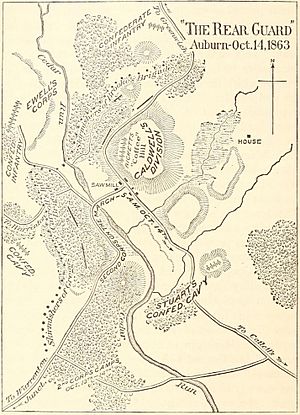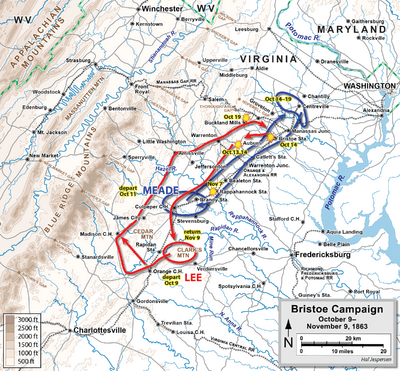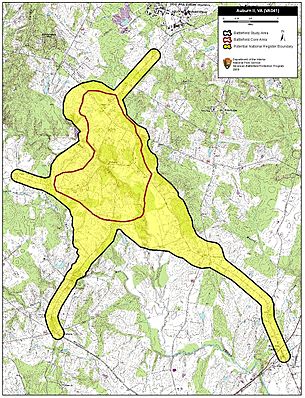Second Battle of Auburn facts for kids
Quick facts for kids Second Battle of Auburn |
|||||||
|---|---|---|---|---|---|---|---|
| Part of the American Civil War | |||||||
 Map of the battle (1886) |
|||||||
|
|||||||
| Belligerents | |||||||
| Commanders and leaders | |||||||
| Gouverneur K. Warren | J.E.B. Stuart | ||||||
| Strength | |||||||
| unknown | 3,000 | ||||||
| Casualties and losses | |||||||
| 113 | |||||||
The Second Battle of Auburn was a small but important fight during the American Civil War. It happened on October 14, 1863, in Fauquier County, Virginia. This battle involved soldiers from the Union (the North) and the Confederate (the South) sides.
The main goal for the Confederates was to rescue their cavalry leader, J.E.B. Stuart. His troops were stuck between two Union army groups. Confederate forces, led by Richard S. Ewell, clashed with the Union's II Corps. This Union group was commanded by Gouverneur K. Warren. Stuart and his men were successfully rescued. However, the Union's supply wagons, which the Confederates hoped to capture, got away. The battle ended without a clear winner.
Why the Battle Happened
In October 1863, after the Battle of Gettysburg, Confederate General Robert E. Lee tried to attack the Union army again. His plan was to go around the Union's right side. This Union army was called the Army of the Potomac. Lee wanted to get closer to Washington, D.C..
The Union commander, George Meade, moved his troops to avoid Lee's attack. On October 13, Confederate General J.E.B. Stuart was sent to find the Union army's left side. He found a long line of Union supply wagons moving back along a railroad. Stuart decided to try and capture these wagons.
He left a small group of soldiers behind at a place called Auburn. Stuart didn't know that a large Union force was also moving towards Auburn from the south. This Union force included the II and III Corps.
The Union soldiers accidentally ran into Stuart's small group at Auburn. This led to a small fight, known as the First Battle of Auburn. The Union forces quickly pushed the Confederates away. The Union II Corps, led by General Gouverneur K. Warren, then camped just south of Auburn. This trapped Stuart's main force between the Union soldiers and the Union wagon train.
Stuart had about 3,000 men, horses, and equipment. He hid them in a wooded valley overnight. During the night, Stuart sent scouts dressed as Union soldiers. They went through the Union lines to tell General Lee about their situation. Lee then sent General Richard S. Ewell's troops to Auburn to help Stuart escape.
The Fight at Auburn
Early on October 14, at 3 a.m., Warren's Union II Corps began to move. They were heading towards Catlett's Station. The ground near Cedar Run, south of Auburn, was very muddy. This was because the Union III Corps had passed through during the night.
The Union supply wagons had trouble moving through the mud. So, General Warren ordered General John C. Caldwell's group to protect the high ground north of the creek. They were to guard the rear of the column and the wagons. Caldwell's men set up camp on the hill and started making breakfast. This hill soon became known as Coffee Hill. Caldwell's soldiers set up a defensive line facing northwest.
At 6:15 a.m., General Ewell's Confederate troops arrived. They were led by General Robert E. Rodes. They quickly started fighting with the Union soldiers on Coffee Hill. The sound of the gunfire reached Stuart, who was still hiding in the valley. He sent scouts to see what was happening.
When Stuart learned about the Union soldiers on Coffee Hill, he acted quickly. He ordered his horse artillery, led by Major Robert Beckham, to a hill east of Coffee Hill. The Confederates then started firing their cannons at the Union soldiers. This caught the Union troops by surprise.
General Caldwell turned his cannons on Coffee Hill to fire back at Beckham's artillery. He moved his soldiers to the western side of the hill for protection. Then, he sent General Alexander Hays's division to attack Beckham's position.
To protect his cannons as they moved away, Stuart sent General James B. Gordon to charge the advancing Union soldiers. This charge briefly stopped the Union attack. A general fight then broke out between the two sides. Stuart ordered Gordon to charge again. This second charge helped Stuart's cavalry escape to the southeast. Gordon was wounded during this charge. Stuart and his men successfully escaped. They went around the Union position and joined other Confederate forces. These forces were led by General Jubal Early and General Fitzhugh Lee. They were southwest of Auburn.
With Stuart's men safely away, the battle became more intense along Ewell's front. Rodes's Confederate troops advanced on Coffee Hill. Caldwell moved his Union cannons back to the west to stop the Confederate attack. Rodes continued his attack from 8 to 9 a.m. Early and Fitzhugh Lee's divisions also joined the fight from the southwest.
By 10 a.m., the fighting had slowed down. For about an hour, only cannons were firing. This continued until the Union column and wagons had safely passed to Catlett's Station. Caldwell then pulled his Union troops back to the east. Rodes's Confederates followed them for a short time. By 1 p.m., all fighting had stopped, and Ewell's Confederates withdrew.
What Happened Next
The battle lasted for most of the morning. It resulted in just over 100 soldiers being wounded or killed on both sides. From a strategic point of view, the battle was a draw. The Confederates successfully rescued Stuart's cavalry, who were in a very dangerous spot. The Union forces, on the other hand, managed to protect their important supply wagons.
After this battle, General Robert E. Lee wanted to keep pushing the Union army. He ordered General A. P. Hill to chase the Union forces east along the railroad. This led to another battle, the Battle of Bristoe Station, later that same afternoon.



